Guitar Scale Modes
This is a brief introduction to guitar scale modes so if you are serious about playing lead guitar you will have to go even deeper into the realm of scale modes. This is the part about scales that can get a little confusing and intimidating. Don’t let yourself get overwhelmed about all this info, because you may never have to use it much. The main purpose for reviewing the different guitar scale modes and how they are built is mainly to give you a basic overview and understanding. Even if you never use the information below, you should still read it. Knowledge is everything, and even a basic understanding of guitar scale modes can be beneficial to any guitarist.
Guitar Scale Modes – How Scales are built…
Basically, scale modes are built from the notes of the “Major” scale. I will start with the “C” Major scale since there are no sharps and flats in this scale (this will make it easier to explain all this). There are 7 notes in the “C” Major scale they are C-D-E-F-G-A-B (no sharps or flats). Each note has a will have a number assigned to it (roman numerals). The small roman numerals (ii, iii, vi, and vii) refer to “minor” scales / chords, and the capital roman numerals (I, IV, and V) refer to “Major” or “Dominant” type scales / chords.

You will sometimes see it written like this…which is the numbering I will use here to explain formulas, note numbers, etc.

Building Modes from the Notes of the Scale
From the Major Scale there are 7 different modes built from each of the 7 notes (one mode for each note of the scale).
The names of the 7 scale modes are – Ionian, Dorian, Phrygian, Lydian, Mixolydian, Aeolian, and Locrian. The mode names originated from ancient Greek times (the names are still used today). In modern music some of the ancient Greek names were given an “alternate” name also (for example “Ionian” is also referred to as “Major Scale” maybe to confuse us even more). The chart below will give you a better look at how the notes of a “C” major scale are numbered and named (the Greek names for the modes and the alternates)…
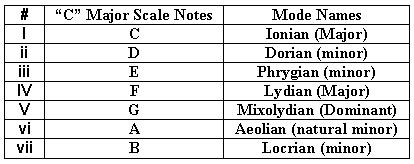
I = the “C Ionian” Major scale mode.
ii = the “D Dorian” minor scale mode.
iii = the “E Phrygian” minor scale mode.
IV = the “F Lydian” Major scale mode.
V = the “G Mixolydian” Dominant scale mode.
vi = the “A Aeolian” natural minor scale mode.
vii = the “B Locrian” minor scale mode.
How the modes are built from each note of a scale…

Each mode uses the same notes of the “Ionian” scale, but starts at a different position.
I – Is the Ionian (Major) Scale Mode, the scale starts on the “C” note, and the notes of the scale are C-D-E-F-G-A-B
ii – Is the Dorian (minor) Scale Mode, the scale starts on the “D” note (the 2nd note of the “Ionian” scale), and the notes of the scale are D-E-F-G-A-B-C
iii – Is the Phrygian (minor) Scale Mode, the scale starts on the “E” note (the 3rd note of the “Ionian” scale), and the notes of the scale are E-F-G-A-B-C-D
IV – Is the Lydian (Major) Scale Mode, the scale starts on the “F” note (the 4th note of the “Ionian” scale), and the notes of the scale are F-G-A-B-C-D-E
V – Is the Mixolydian (Dominant) Scale Mode, the scale starts on the “G” note (the 5th note of the “Ionian” scale), and the notes of the scale are G-A-B-C-D-E-F
vi – Is the Aeolian (minor) Scale Mode, the scale starts on the “A” note (the 6th note of the “Ionian” scale), and the notes of the scale are A-B-C-D-E-F-G
vii – Is the Locrian (minor) Scale Mode, the scale starts on the “B” note (the 7th note of the “Ionian” scale), and the notes of the scale are B-C-D-E-F-G-A
Intervals / Formula’s / Notes
Even though the scale modes are using the notes of the “C” Ionian Scale (C Major Scale) for our examples on this menu page – each scale mode will have its own distinctive sound to it. Why? This is because of the “Intervals” associated with each of the guitar scale modes. Intervals are described as the “distance” between each note. Half-steps are one fret away (notes that are right next to each other), and Whole-steps are two frets away (notes that have one fret between them).
This example uses the C – Ionian Scale (no sharps or flats) showing the whole steps and half steps that make up the scale…

* Half Steps are between E and F, B and C* Whole Steps are between C and D, D and E, F and G, G and A, A and B
Now let’s take a look at how the “Intervals” are “Mapped” over the scales…
I will use the C – Ionian (Major scale), and the D – Dorian scales as the examples. The numbers associated with the “Formulas” correspond to the notes of the scales.
C Ionian Scale Example
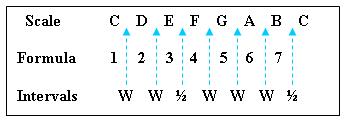
Now if we start on the 2nd note of the C Ionian scale (which is a D note) we get a D – Dorian scale.
D Dorian Scale Example
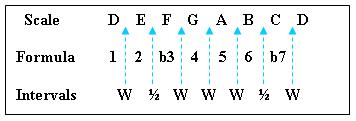
The formula for the C Ionian scale would be: 1 2 3 4 5 6 7
The intervals for the C Ionian scale would be: W W ½ W W W ½
The formula for the D Dorian scale would be: 1 2 b3 4 5 6 b7
The intervals for the D Dorian scale would be: W ½ W W W W ½
The examples above will conclude that the placement of Whole Steps and Half Steps determine the guitar scale modes. The notes in both the C Ionian and the D Dorian scales are the same (there are no sharps or flats) – they just start on different notes.
Here are the 7 scale modes for C Ionian (C Major) and the Notes / Formulas for each mode…
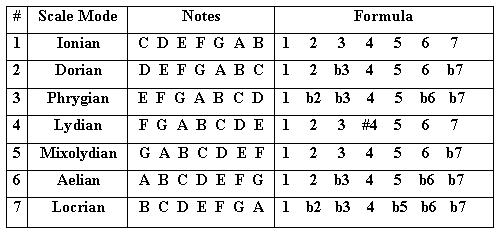
Building Chords from Guitar Scale Modes
While I am not trying to make this more complicated than it already is, I need to mention how Chords are built from each of the scale modes. The basic formula that is used is “1 – 3 – 5” for building chords (there are more formulas, but for these examples we will only be using a couple). It’s actually quite simple, using the formula 1 – 3 – 5 you get the C – E – G notes.
These 3 notes make up the “C Major” chord.
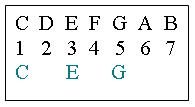
Let’s try it with the second mode of the C Ionian scale – The D Dorian mode (which is a minor mode). Again, using the formula 1 – 3 – 5 you get the D – F – A notes.
These 3 notes make up the “D minor” chord.
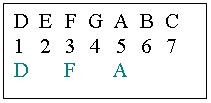
Building a Major 7th Chord
It’s simple, using the formula 1 – 3 – 5 – 7 you get the C – E – G – B notes.
These 4 notes make up the “C Major 7th” chord.

If you think about it, Chords are built from the notes of the guitar scale modes, and if you use certain formulas you get certain chords.
This was meant to be a quick review of how chords are built from guitar scale modes. All the subjects covered on this menu page are much more intense than what is covered here.
What does all this have to do with you and your guitar playing?
I would suggest learning what’s on our Advanced Scales 1 page, try to master it, and then make a decision on whether or not you want more? Keep in mind that guitarists go to music schools or study in college for years to master scale modes and all this chord building theory stuff. So it is what it is, if you want more, you will have to go to school, or take lessons, etc. If you are serious about learning more about scale modes, I would recommend that you hook up with an experienced guitar teacher. A good guitar teacher can help you get to where you need to be faster and more efficiently – and they can also keep an eye on your progress.
I cannot stress enough that there is really no other way to become highly skilled at playing scales other than lots of practice. The more time you put into it, the more you will get out of it. lots of repetition and hard work is the only way!


